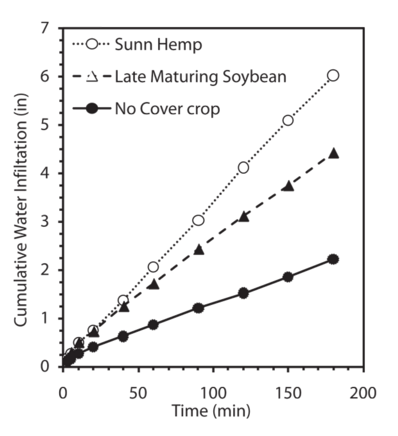By Peter Tomlinson, Environmental Quality Specialist
Earthworms play an important role in soil as they redistribute organic matter, influence soil fertility, and affect soil physical properties. While earthworms are not essential for the formation of well-aggregated soil, their presence can contribute significantly to the formation and stabilization of aggregates and improve soil structure. Earthworm casts — the excreted mixture of soil and organic matter — can develop into stable soil aggregates. Depending on the species, the cast material may be deposited in the burrow or on the soil surface.
Earthworm-driven improvements in soil structure (photo) can result in positive changes in soil porosity, aeration, water-holding capacity, and the rate of water infiltration.
What effects do cultivation and soil health practices have on earthworm populations?
Earthworm populations generally become reduced in cultivated agricultural fields. Several explanations for the decline and loss of earthworms have been proposed:
- Tillage implements cause physical injury to earthworms resulting in mortality.
- Reductions in residue and soil organic matter associated with long-term tillage restrict food supplies.
- A change in soil temperature resulting from the loss of insulation provided by the vegetation.
- Increased predation from birds when the soil is turned over.

The addition of cover crops can further benefit earthworm populations. In a long-term cover crop study conducted at the former K-State Harvey County Experiment Field in Hesston from 2002-08, more earthworms were counted in the plots that had either late-maturing soybean or sunn hemp cover crops (Figure 2).
Improved cumulative water infiltration (Figure 3) was also observed in the cover crop treatments of the study and followed the same pattern as the earthworm populations. The greatest levels of cumulative water infiltration and earthworm populations were in the sunn hemp treatment while the “no cover crop” treatment had the lowest cumulative water infiltration and earthworm populations.

How do you assess earthworms as an indicator of changing soil health?
It is important to understand that you will not see changes in earthworm populations immediately after a change in management practices. In fact, it will likely take many years to observe a change in earthworm populations. The key is to collect baseline population information before you make a management change and then repeat the measurements every few years, being consistent in your sampling date.
The recommended time of year to count earthworms is the late spring (April to May) or mid-fall (October to November). It is best to identify at least four locations that are representative of the field and will provide an indication of the spatial variability of the earthworms. Over time you will want to be able to go back to the same general sampling location.
To assess your earthworm population, dig a cubic foot of soil and hand sort the soil, keeping track of how many earthworms you find. The typical range for earthworm numbers in a cubic foot of soil in an agricultural field is 5-30, but may be higher depending on tillage and soil organic matter.





